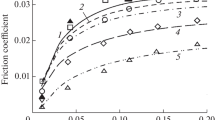Abstract—
The study considered the known hydrodynamic friction model based on the generalized Eyring equation and taking into account the phenomenon of oil film self-heating. The concept of effective friction coefficient is introduced the use of which makes it possible to perform bearing dynamic simulation taking into account the dependence of friction coefficients on cyclically changing contact forces without increasing the calculation time. The effective friction coefficients of the contacts with the inner and outer rings are calculated for the range of specified slip values. As a result, dependences of the effective friction coefficients on slippage of both the cage and the rolling elements are obtained. These dependences have the same form as conventional friction curves: as slip increases, the effective friction coefficient first increases and reaches a certain maximum value, and then decreases, which is caused by self-heating of the oil film and a decrease in its viscosity. A decrease in the friction coefficient during bearing operation, in turn, leads to even greater slippage. A process with such a “positive feedback,” if not interrupted, leads to an increase in heating of the oil, a decrease in the thickness of the oil film and, as a result, to its rupture, the occurrence of boundary friction, intense wear, and seizure. The amount of cage slip that achieves the maximum effective friction coefficient on the inner ring is critical. In the example considered in the paper, the critical slip of the cage is 11%. The slip allowed during operation of the bearing must be determined taking into account the margin in relation to its critical value.




Similar content being viewed by others
REFERENCES
Kannel, J.W. and Walowit, J.A., Simplified analysis for tractions between rolling sliding elastohydrodynamic contacts, J. Lubr. Technol., 1971, vol. 93, no. 1, pp. 39–44.
Kodnir, D.S., Zhil’nikov, E.P., and Baiborodov, Yu.Z., Elastogidrodinamicheskii raschet detalei mashin (Elastohydrodynamic Calculation of Machine Parts), Moscow: Mashinostroenie, 1988.
Sakaguchi, T. and Ueno, K., Dynamic analysis of cage behavior in a cylindrical roller bearing, NTN Tech. Rev., 2003, no. 71, pp. 8–17.
Ford, R.A.J., and Foord, C.A., The effects of elastohydrodynamic traction behavior on cage slip in roller bearings, ASME J. Lubr. Technol., 1974, vol. 96, no. 3, pp. 370–375.
Poplawski, J.V., Slip and cage forces in a high-speed roller bearing, ASME J. Lubr. Technol., 1972, vol. 94, pp. 143–150.
Kragelskii, I.V., Friction and Wear, London: Butterworth, 1965.
Muraki, M., EHL traction and related rheological parameters under high temperature conditions J. Synth. Lubr., 1992, vol. 9, no. 1, pp. 29–43.
Muraki, M., Molecular structure of synthetic hydrocarbon oils and their rheological properties governing traction characteristics, Tribol. Int., 1987, vol. 20, no. 6, pp. 347–354.
Harris, T.A. and Kotzalas, M.N., Essential Concepts of Bearing Technology (Rolling Bearing Analysis), Boca Raton, FL: CRC Press, 2007.
Balyakin, V.B., Zhilnikov, E.P., Kosenok, B.B., and Lavrin, A.V., Study of the influence of ring misalignment in rolling bearings on frictional torque and the fatigue life of supports, J. Frict. Wear, 2017, vol. 38, no. 1, pp. 7–12.
Klebanov, Ya.M., Murashkin, V.V., Polyakov, K.A., and Danil’chenko, A.I., Dynamic loading in high-speed ball bearings, Russ. Eng. Res., 2018, vol. 38, no. 1, pp. 65–71.
Author information
Authors and Affiliations
Corresponding author
About this article
Cite this article
Klebanov, I.M., Polyakov, K.A., Petrov, V.R. et al. Slip in Roller Bearings under Hydrodynamic Contact Friction. J. Frict. Wear 43, 74–79 (2022). https://doi.org/10.3103/S1068366622010068
Received:
Revised:
Accepted:
Published:
Issue Date:
DOI: https://doi.org/10.3103/S1068366622010068




